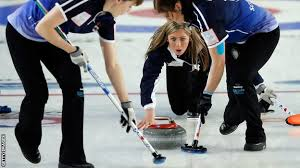BY L P BEERE, A MURRAY, M BELCH, B WALKER, SPORTSCOTLAND INSTITUTE OF SPORT, SCOTLAND.

Objective: Despite more than 2 million players worldwide, little is known about injuries in curling. There are only 2 published studies on injury epidemiology. This report describes the injuries seen in high-performance British/ Scottish curlers between 2000-2010, many of whom have been successful in World Championships and most recently in the 2014 Winter Olympic games.
Design: Athletes receive regular medical care and physiotherapy, and complete health profiling by questionnaire. Records were kept of each encounter with a health professional. Data was entered into a database, and analysed. A probability (p) value of ≤0.05 was used to denote statistically significant results. Information regarding the frequency and type of training was gathered, as well as physical characteristics relevant to risk factors for injury.
Setting: The SportScotland Institute of Sport.
Patients: The 51 high performance curlers at the SportScotland Institute of Sport during this time.
Results: A total of 216 injuries were seen in the 51 high-performance level curlers during the study. Most injuries occurred in the spine (39), knee (33), and shoulder (25) regions. There were also 56 other muscular injuries.
Conclusions: This is the first retrospective study looking at injury prevalence and pattern in high-performance curlers. Injuries to the spine, knee and shoulder regions were found to be the most common. This is similar to Reeser and Berg’s findings of injury patterns amongst recreational curlers, who self reported their injuries. It is thought that most of these injuries are overuse in nature. Further research would aid ongoing injury prevention strategies and could include a prospective analysis of injuries and potential factors causing them.

Background With over 2 million participants worldwide, curling has enjoyed Olympic medal status since the Nagano Winter Games in 1998. It is therefore surprising that there is little published research on injuries associated with curling. Australian Rules Football has approximately 650,000 players worldwide, yet has at least 150 publications looking at injury prevalence and training methods. By comparison, there are only 2 published studies on injury epidemiology focusing on curling, in which either only recreational athletes were studied1, or where only a small number of injuries were reported2. This report aims to retrospectively describe injuries patterns in high-performance curlers between 2000 and 2010. Invented in Scotland in 1541, the aim of curling is to deliver the ‘stone’ into a target zone. The delivery of the stone involves pushing the stone along the ice, before releasing the stone towards the target.” After releasing the stone, the curler slides along the ice, observing the stone. The tuck side – a player’s non-dominant side – is maintained in a high degree of knee and hip flexion throughout this motion. The action of sweeping demands continual forward flexion of the hip, with rapid, repetitive upper limb movement.3 Scotland has a history of high performance internationally, with Scottish athletes winning Olympic Gold in 2002, silver and bronze at Sochi 2014, and world championship gold in 1967,1991,1999,2002, 2006 ,2009 and 2013. To succeed in Olympic or World Championship competition, curlers are required to win 11 matches, each of which last 3-4 hours. This is the greatest amount of playing time required to win an Olympic gold, in either the Summer or Winter Games.
Aim The aim was to document injuries seen in high-performance curlers in Scotland between 2000-2010. The frequency and nature of the injuries will inform injury prevention strategies, and medical provision for squads. Injury was defined as an event that needed physiotherapy or medical treatment which resulted in any loss of training or playing time.
Methods Scotland’s high-performance squad were, and remain so to the present day, under the care of the SportScotland Institute for Sport. At present, and historically Great British teams are predominantly made up of Scottish athletes. Each encounter with a health professional was recorded, including details of physiotherapy sessions, training methods, medical history and physical characteristics. The information from all clinical encounters was documented in a standardized booklet, by either the attending doctor or physiotherapist. Information regarding the frequency and type of training was also gathered, as well as physical characteristics relevant to risk factors for injury.
Data analysis All data was statistically analysed using SPSS (SPSS for Windows, versions 18.0). Descriptive statistics regarding athletes’ age, gender and injury type, frequency and location were grouped and analysed using a 2 sample t-test. The same test was used to compare the number of injuries between male and female athletes. One way ANOVA was used to compare the different training protocols used by athletes in relation to injury prevalence. Statistical significance was denoted by p=<0.05.
Results The 51 high-performance curlers under the care of the SportScotland Institute for Sport had a total of 216 injuries during this time. Mean age of the curlers was 37.1 years (range 21-56), with 29 female and 22 male athletes. On average, 4.32 injuries (range 1-10, SD 2.21) were sustained by each athlete. The incidence of injuries was higher in male (113 injuries in 20 athletes, mean 5.63; S.D 2.27) compared to female athletes (103 injuries in 29 athletes, mean 3.55; S.D 1.84), (p = 0.03, 95% C.I 0.68, 3.02). BMI ranged from 19.6 – 50.1 (mean 26.03; S.D 4.52). Those with a BMI <25 had 124 injuries in 30 athletes (mean 4.13, S.D 2.2) and those with a BMI >25 had 92 injuries in 20 athletes ((mean 4.6; S.D 2.28); 2 sample t-test p = 0.44, 95% C.I -1.808, 0.80). The majority of these injuries were of the spine (39), knee (33), and shoulder (25) regions. However, the majority of injuries were muscular in nature. The type and frequency of training of each athlete was also examined. Training data was not available for 8 athletes. Seven athletes performed cardiovascular training alone, with 30 injuries seen in this group (mean 4.28, S.D 1.7). 21 athletes did a combination of CV and weights training (106 injuries, mean 5.04, S.D 2.31), and 14 athletes combined CV, weights and sports specific exercises (60 injuries, mean 4.28, S.D 2.26). 1 curler used swimming only as their form of training, with 4 injuries occurring in this athlete. There were no significant differences between the training groups when tested with one-way ANOVA (p=0.542).
Discussion Currently, there is a distinct lack of research into curling injuries, particularly at an high-performance level, with only 2 papers currently identified, the first of which used only recreational athletes. This retrospective analysis is the first long term analysis of high-performance curlers and reports on the injuries they commonly sustain. Injuries to the spine (56), knee (33) and shoulder (25) regions were found to be the most common. In total, 28 curlers (54%) suffered some form of knee injury, 31 (61%) experienced injury to their back, and 25 (49%) had injuries in the shoulder region. This is similar to Reeser and Berg’s findings of injury patterns amongst recreational curlers, who self reported their injuries. They found spine injuries to again be the most prevalent (54% of curlers questioned), with knee and shoulder injuries in 33% and 20% respectively.1 Similarly, the study by Berry et al2 found that curling injury incidence was low, with an overall injury rate of 0.07 injuries per game studied at the 2008 World Championships, with only one injury leading to loss of playing time. They also found the injuries were ‘curling-specific’. Following discussions with senior physiotherapists and sports medicine specialists, it is thought the majority of these injuries are overuse in nature, with the ‘tuck’ position during delivery a likely source of knee pain. A study by Yoo et al 3 into the biomechanics of stone delivery in 2012 highlighted that due to superior coaching and training, high-performance curlers were able to ‘maintain a regulated movement speed and balance control’ compared with recreational players. However, this study shows that despite this superior technique, the high-performance curlers still experienced knee, ankle and foot injuries. This needs to be prospectively studied in order to gain a greater understanding of the biomechanics which can be related to the individual athlete, and how this can prevent injuries in the future. Body mass and joint angles were also found to be the two key elements when determining the force during delivery and this study suggests that an increased BMI is associated with an increased injury rate, although this was not statistically significant. Injuries to the wrist and hands were more likely to be due to falls on the ice, or the repetitive nature of sweeping, or injuries sustained away from curling. Surprisingly, injuries were significantly higher in men than women, for no clear reason. There appears to be no difference in training method related to injury prevalence (p=0.542), with those doing CV alone or CV, weights and sports specific training both seeing an average of 4.28 injuries per athlete. Further studies are required to understand the training protocols required to minimise injury risk in curlers, and this may be paired with biomechanical analysis to better understand the needs of curlers with respect to training and injury prevention. Due to these athletes undergoing rigorous medical profiling by professionals, this study is not subject to recall bias. Although the study is limited by its sample size, this study displays consistent injury profiles amongst the high-performance curlers of Scotland.
Conclusions Although safer than other winter sports, where injury rates in events such as skiing and snowboarding are many times greater 4,5, prevention of injury, particularly at the high-performance level where success determines future funding is paramount. This report is the first long-term retrospective analysis of injury patterns in high-performance curlers, and should provide insight for players, coaches, physiotherapist and doctors. The support team will be able to target and monitor the appropriate areas in training. Medical teams attending curling events will be better informed as to what type of injuries they should expect. The importance of biomechanics using detailed imaging and video techniques in preventing injury, particularly the tuck position during delivery of the stone1,2,3 should be explored in more depth. The build up to the Sochi Winter Games in 2014 and subsequent World Championships will provide ample opportunity. Further research will aid ongoing injury prevention strategies6,7 and provide evidence to support the need for a better understanding of the effects of biomechanics8 in curling.
References
- Reeser J.C, Berg R.L. Self reported injury patterns among competitive curlers in the United States: a preliminary investigation into the epidemiology of curling injuries. Br J Sports Med 2004;38:e29 doi:10.1136/bjsm.2003.010298
- Berry J.W, Romanick M.A, Koerber S.M. Injury Type and Incidence Among high-performance Level Curlers During World Championship Competition. Research in Sports Medicine: An International Journal. Volume 21, Issue 2, 2013:159-163
- Yoo KS, Kim HK, Park JH. A Biomechanical Assessment of the Sliding Motion of Curling Delivery in high-performance and Sub-high-performance Curlers. J Appl Biomech. 2012 Dec;28(6):694-700
- Torjussen J, Bahr R. Injuries among competitive snowboarders at the national high-performance level. Am J Sports Med. 2005 Mar;33(3):370-7.
- Flørenes TW, Nordsletten L, Heir S et al. Injuries among World Cup ski and snowboard athletes. Scand J Med Sci Sports. 2012 Feb;22(1):58-66.
- Engebretsen L, Steffen K, Alonso JM, et al. Sports injuries and illnesses during the Winter Olympic Games 2010. Br J Sports Med. 2010 Sep;44(11):772-80.
- Ljungqvist A, Jenoure P, Engebretsen L, et al. The International Olympic Committee (IOC) consensus statement on periodic health evaluation of high-performance athletes March 2009. Br J Sports Med 2009;43:631–43.
- Krosshaug T, Andersen TE, Olsen OE, et al. Research approaches to describe the mechanisms of injuries in sport: limitations and possibilities. Br J Sports Med2005;39:330–9.
********************************************
The authors work/ have worked as part of a multidisciplinary team at the SportScotland Institute of Sport (@sportscotland) which look after the elite level British curlers. The sport has developed a new popularity since recent World Championship and Winter Olympic success